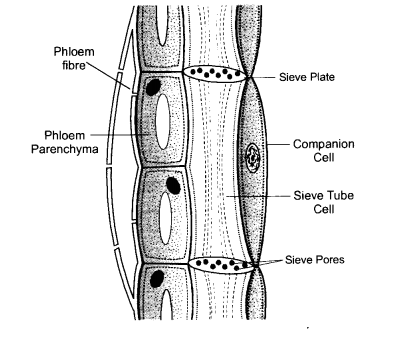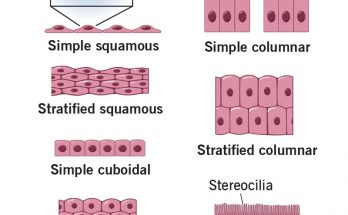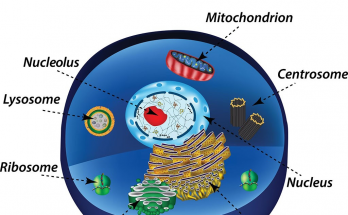Phloem Tissue is a specialized transport system that is essential for the distribution of nutrients and other organic molecules throughout the plant.
Table of Contents
Constituents of Phloem
Phloem is a complex tissue that is composed of several constituents they are as follows –
- Sieve cells
- Sieve tubes
- Companion cells
- Phloem Parenchyma
- Phloem fibers
- Phloem Sap

Each of these cell types plays a unique role in the transport of organic molecules from the leaves to other parts of the plant.
Phloem is an essential tissue for plant survival, as it provides a means of distributing nutrients, sugars and other organic molecules throughout the plant. Without Phloem Plants would not be able to grow, develop or reproduce.
In this article we will explore the constituents of Phloem with their structures, functions and importance in plant physiology. We have also explained the role of Sieve Tubes, Companion Cells, Parenchyma cells and Fibers in Phloem transport and discuss their unique contributions to plant growth and development.
Also check – Phloem – Definition, Structure, Function, Types and How does Phloem tissue work
Constituents of Phloem – Definition, Structure, Function and Importance
Sieve Tubes – Definition, Structure, Function and Importance
Sieve Tubes – Definition
Sieve Tubes are specialized cells found in the Phloem tissue of vascular plants. Sieve Cells are long, narrow cells that are connected end-to-end to form Sieve Tube elements. The walls of Sieve Tube elements contain numerous perforations called Sieve Plates, which allow for the movement of nutrients and other molecules between Adjacent Cells.
Sieve Tubes – Structure
- Sieve Tube elements are living cells that lack nuclei and other organelles.Sieve Tubes consist of cylindrical cells that are lined end-to-end to form a continuous tube-like structure.
- They are filled with a dense cytoplasm that contains various proteins and Enzymes.
- The walls of Sieve Tube elements are composed of Cellulose, Hemicellulose and pectin and are strengthened by Lignin. The Sieve Plates are composed of a specialized protein called Callose.It forms a mesh-like structure that helps to regulate the flow of nutrients and other molecules.
- The end walls of Sieve Tube elements are modified to form Sieve Plates, which contain numerous perforations or pores that allow the passage of solutes from one Sieve Tube element to the next. . These pores allow for the movement of Phloem Sap between adjacent sieve elements, creating a continuous pathway for the transport of nutrients.
- Adjacent to each Sieve Tube element is a Companion Cell, which is a small, nucleated cell that provides metabolic support to the Sieve Tube element. Companion Cells are connected to Sieve Tube elements by plasmodesmata, narrow channels that allow for the exchange of molecules between adjacent cells.
- Companion Cells are responsible for providing metabolic support to sieve elements, as sieve elements lack many of the organelles necessary for protein synthesis and other metabolic processes.
Sieve Tubes – Function
The main function of Sieve Tubes is to transport organic nutrients, such as sugars and amino acids, from the leaves, where they are produced by photosynthesis, to other parts of the plant, such as the roots, stems and flowers. This process is called translocation and is driven by a pressure gradient known as the pressure flow hypothesis. The pressure flow hypothesis suggests that the high concentration of organic nutrients in the source tissue (i.e. the leaves) creates a pressure gradient that drives the movement of nutrients through the Sieve Tubes to the sink tissue (i.e. the non-photosynthetic parts of the plant).
Sieve Tubes Importance in Plant Physiology
- Sieve Tubes play a critical role in the growth and development of vascular plants.
- They allow for the efficient transport of nutrients and other molecules throughout the plant, which is essential for maintaining metabolic processes and supporting growth.
- Sieve Tubes are also involved in the regulation of plant defense mechanisms against pathogens and pests. For example callose deposition at the Sieve Plates can prevent the spread of viruses and other pathogens through the Phloem tissue.
Also Check – 15 Difference between Xylem and Phloem
Companion Cells -Definition, Structure, Function and Importance
Companion Cells -Definition
Companion Cells are specialized cells found in plants that are intimately connected to Sieve Tube elements, which form part of the Phloem, the tissue responsible for the transport of sugars, amino acids and other organic molecules throughout the plant. Companion Cells have an important role in regulating and supporting the function of Sieve Tube elements.
Companion Cells – Structure
- Companion Cells are small, nucleated cells that are connected to Sieve Tube elements by numerous plasmodesmata, which are narrow channels that allow for the exchange of molecules between adjacent cells.
- The cytoplasm of Companion Cells is rich in organelles like mitochondria and ribosomes.It provides the energy and building blocks needed for the synthesis and transport of organic molecules.
- Companion Cells are also characterized by the presence of numerous infoldings of their plasma membrane. These infolding greatly increase the surface area of the plasma membrane, allowing for efficient exchange of molecules between the Companion Cells and Sieve Tube elements.
- The cell walls of Companion Cells are composed of cellulose and other polysaccharides and are reinforced by specialized proteins, including structural proteins and proteins involved in cell signaling.
Companion Cells – Function
- The primary function of Companion Cells is to support the metabolism and function of Sieve Tube elements, which are responsible for the transport of organic molecules throughout the plant.
- Companion Cells are responsible for loading and unloading of organic solutes such as sugars, amino acids and hormones into and out of the Sieve Tubes, respectively.
- They also regulate the osmotic pressure in the Sieve Tubes which is essential for the transport of these solutes.
- Companion Cells provide energy to Sieve Tube elements by transporting ATP and other energy-rich molecules.
Companion Cells – Importance in Plant Physiology
Companion Cells play a critical role in the physiology of plants. They are essential for the proper functioning of the Phloem which is responsible for the distribution of organic molecules throughout the plant. The efficient functioning of the Phloem is critical for the growth and development of plants, as well as for their response to various environmental stresses such as drought, salinity and temperature changes. Additionally, Companion Cells have been shown to play a role in the regulation of plant growth and development, as well as in the defense against pathogens.
Also check – Functions of the Xylem and Phloem
Phloem Parenchyma -Definition, Structure, Function and Importance
Phloem Parenchyma – Definition
Phloem parenchyma is a type of living parenchyma cell found in the phloem tissue of plants. These cells are responsible for storing and transporting organic nutrients, such as sugars and amino acids, throughout the plant.
Phloem Parenchyma – Structure
Phloem parenchyma cells are typically small and have thin cell walls. They are often elongated in shape and have a large central vacuole. These cells contain numerous organelles like mitochondria, ribosomes and endoplasmic reticulum, which are involved in the synthesis and transport of organic compounds.
Phloem Parenchyma – Function
Phloem parenchyma cells perform several important functions in plants. –
- Storage of organic nutrients – Phloem parenchyma cells store and transport organic nutrients, such as sugars, amino acids and other metabolites to various parts of the plant.
- Transport of Nutrients – Phloem parenchyma cells transport nutrients from the phloem sieve tubes to other parts of the plant.
- Support – Phloem parenchyma cells provide structural support to the phloem tissue and the plant as a whole.
- Metabolic activity – Phloem parenchyma cells are metabolically active and can synthesize and break down various organic compounds as required by the plant.
Phloem Parenchyma – Importance in Plant Physiology
- Source-sink relationships- Phloem parenchyma cells are involved in maintaining the balance between source and sink organs in plants. Source organs, such as leaves, produce organic nutrients through photosynthesis, while sink organs, such as roots and fruits, require these nutrients for growth and development. Phloem parenchyma cells help transport these nutrients from the source to the sink organs.
- Plant growth and development – Phloem parenchyma cells are involved in the growth and development of the plant. They provide structural support and transport nutrients that are required for cell division and expansion.
- Response to stress – Phloem parenchyma cells play a role in the plant’s response to stress, such as drought, salinity, or nutrient deficiency. They can store and transport nutrients to the parts of the plant that need them the most, helping the plant survive in adverse conditions.
Also Check- What are the Differences between the Transport of Materials in Xylem and Phloem
Phloem Fiber- Definition , structure , function and Importance in Plant Physiology
Phloem Fiber – Definition
Phloem fibers are elongated, spindle-shaped cells that are found in the phloem tissue of plants. They are a type of sclerenchyma cell and are characterized by their thick cell walls, which are made up of lignin and cellulose.
Phloem Fiber – Structure
- Phloem fibers have a unique structure that enables them to provide structural support to the plant. They are elongated cells that can range in length from a few millimeters to several centimeters. They have a thick secondary cell wall, which is made up of lignin and cellulose. The secondary cell wall is responsible for the strength and rigidity of the cell.
Phloem Fiber- Function
Phloem fibers perform several important functions in plants they are as follows –
- Structural support: Phloem fibers provide structural support to the phloem tissue and the plant as a whole. They are responsible for maintaining the shape and rigidity of the plant.
- Protection: Phloem fibers provide protection to the plant by forming a physical barrier that can prevent the entry of pathogens and other harmful substances.
- Transport of nutrients: Phloem fibers are involved in the transport of nutrients, such as sugars and amino acids, from the leaves to the rest of the plant. They help maintain the flow of nutrients in the phloem tissue and prevent blockages.
Phloem Fiber – Importance in Plant Physiology
- Maintenance of plant structure- Phloem fibers provide the plant with structural support which is essential for the proper growth and development of the plant.
- Transport of nutrients – Phloem fibers are involved in the transport of nutrients from the source to the sink organs in the plant. This helps maintain the balance between source and sink organs and ensures that the plant is able to grow and develop properly.
- Response to stress – Phloem fibers can play a role in the plant’s response to stress, such as drought, salinity or nutrient deficiency. They can help transport nutrients to the parts of the plant that need them the most. This helps the plant survive in adverse conditions.
Phloem Sap – Definition, Composition and functions
Phloem Sap – Definition
Phloem Sap is a nutrient-rich fluid that flows through the Phloem tissue of vascular plants. The Phloem tissue is responsible for transporting the food produced in the leaves (photosynthates) to the other parts of the plant, including the roots, stems and flowers. Phloem Sap is the medium through which these nutrients are transported.It is a nutrient-rich liquid that contains a variety of organic compounds, such as sugars, amino acids and hormones.
Phloem Sap – Composition
- Phloem Sap is a complex mixture of organic and inorganic compounds, including sugars, amino acids, proteins, hormones and inorganic ions. The most abundant components of Phloem Sap are sucrose and other sugars. It provides the energy needed for plant growth and development. Other important components of Phloem Sap include amino acids, which are essential for protein synthesis and hormones.It regulates various physiological processes in plants.
- The composition of Phloem Sap can vary depending on the type of plant, the stage of growth and the environmental conditions. For example- the concentration of sugars in Phloem Sap can increase in response to high light intensity, while the concentration of amino acids can decrease under conditions of water stress.
- Phloem Sap also contains a variety of proteins, including enzymes and structural proteins. These proteins are involved in various physiological processes, such as the regulation of metabolism and the maintenance of cell structure.
- In addition to organic compounds, Phloem Sap also contains inorganic ions, such as potassium, calcium and magnesium. These ions play important roles in plant growth and development, including the regulation of enzyme activity and the maintenance of osmotic balance.
Phloem Sap – Functions
- The main function of Phloem Sap is to transport nutrients produced in the leaves through photosynthesis to other parts of the plant.
- Phloem Sap carries sucrose, which is synthesized in the mesophyll cells of the leaves and then transported to the Phloem Sieve Tubes. The sucrose is then transported through the Phloem tissue to other parts of the plant, where it is used for growth, respiration and other metabolic processes.
- In addition to transporting sucrose, Phloem Sap also transports other organic compounds, including amino acids, hormones and RNA molecules. These compounds are important for regulating plant growth and development, as well as responding to environmental stresses.
- Another important function of Phloem Sap is to transport signals and messages between different parts of the plant. For example- Phloem Sap can carry information about environmental conditions such as changes in temperature, light or water availability. This information can then be used by other parts of the plant to adjust their growth and development accordingly.
- Source-sink regulation- Phloem sap is responsible for the transport of nutrients from source organs, such as the leaves, to sink organs, such as the roots and developing fruits. This helps regulate the balance between the source and sink organs and ensures that the plant is able to grow and develop properly.
- Defense against herbivores and pathogens – Phloem sap can contain defense compounds that protect the plant from herbivores and pathogens. For example, alkaloids and phenolics can deter herbivores from feeding on the plant, while tannins and lignins can help prevent the entry of pathogens.
Also Check- Components of Xylem
Also Check- Complete Notes Of Chapter 6 Tissue
Also Check – Difference between Plant Tissues and Animal Tissues
Frequently asked questions on this topic
What is Phloem tissue and why is it essential for plants?
How many constituents does Phloem tissue have and what are their names?
What is the function of Sieve Cells in Phloem transport?
What are Sieve Tubes and what is their structure?
What are Sieve Plates and what is their role in Phloem transport?
What is a Companion Cell and what is its function in Phloem transport?
How are Companion Cells connected to Sieve Tube elements in Phloem transport?
What is the role of plasmodesmata in Phloem transport?
What is the main function of Sieve Tubes in Phloem transport?
What is the pressure flow hypothesis and how does it relate to Phloem transport?
What is the importance of Sieve Tubes in plant physiology?
What is the role of Companion Cells in supporting the function of Sieve Tubes?
What are the cell walls of Companion Cells made of and what are they reinforced by?
What is the primary function of Companion Cells in Phloem transport?



4 Comments on “What are the Constituents of Phloem ?”